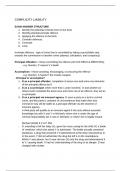COMPLICITY LIABILITY
EXAM ANSWER STRUCTURE
1. Identify the potential criminal event in the facts
2. Identify potential principle offence
3. Applying the offence to the facts
4. Consider defences
5. Conclude
6. Loop
Inchoate offences - type of crime that is committed by taking a punishable step
towards the commission of another crime (attempt, solicitation, and conspiracy)
Principal offenders = those committing the offence (ACTUS REUS & MENS REA)
- e.g. Murder | P causes V’s death
Accomplices = those assisting, encouraging, or procuring the offence
- e.g. Murder | A hands P the murder weapon
: Principal or accomplice?
1. D as a principal offender: completion of actus reus and mens rea elements
of the principal offence by D
2. D as a co-principal: when more than 1 actor involved, D and another (or
others) each complete the actus reus and mens rea of an offence, they act as
co-principals
3. D as a principal via innocent agency: D uses a party as a tool to commit
crime, and this party is unaware of circumstances that make their acts
criminal D may still be liable as a principal offender via the doctrine of
innocent agency
- A third party will qualify as an innocent agent if she acts without essential
knowledge (as with X and Y in Michael); where she is under the age of
criminal responsibility (as X was in Michael); or where she is legally insane.
Michael (1840) 9 C & P 356
- D, intending to kill her baby (V), gave the nurse caring for the child (Y) a bottle
of ‘medicine’ which she asked Y to administer. The bottle actually contained
laudanum, a drug that would kill V if administered at the dose instructed by D.
In the event, Y did not administer the drug but left it on the mantelpiece.
Whilst Y was absent, her 5-year-old son (X) took the drug and administered it
to V, causing death. X had no understanding of the drug or its danger. D was
charged with murder.
, 1. !!!!D as an accomplice: D is an accomplice to a principal offence where,
rather than completing the actus reus of the offence herself, she aids, abets,
counsels, or procures P to commit the offence (ACTUS REA), and P does so.
In modern language, this requires D to have assisted or encouraged P, or to
have caused P’s offence to come about.
2. Uncertainty as to a given D’s role (P or A)/ uncertainty whether D is a
principal or an accomplice
- D1 and D2 attack V and V dies
- No evidence of: death via a cumulative effect + who did what for sure
- BUT evidence of: either D1 or D2 delivering the fatal blow
- D1 and/or D2 can be liable for murder! | Depends on strength of evidence
Giannetto
- D threatened to kill his wife (V) and hired another party (Y) to kill her. V was
killed, but it could not be proved who killed her. D was charged with murder on
the basis that he either killed V himself as a principal or she was killed by
someone on his behalf (ie he was an accomplice).
- COA HELD: only have to show if either principle or accomplice, can be liable
for murder, can have uncertainty, conviction upheld on appeal. D may be
liable in these circumstances even where the jury are not unanimous on what
role he played, as long as they were sure that he was either a principal or an
accessory.
- If evidence cannot show that if D1 is not the P, then he is A → acquittal!\
must be innocent beyond reasonable doubt, if there is doubt must acquit
- Legal uncertainties & factual uncertainties can arise when separating
principal offenders and accomplices.
Complicity by aiding, abetting, counselling, or procuring
Where D aids, abets, counsels, or procures P to commit a principal offence, and P
does so, D is labelled and punished as if she committed the principal offence herself.
ACTUS REUS OF AIDING, ABETTING, COUNSELLING, OR PROCURING
- D’s conduct only needs to satisfy one of these terms to complete the actus
reus.
Aiding, abetting or counselling
Interpreted to mean no more than assisting or encouraging
‘Aiding’ = assisting, D may assist at the time P commits the principle offence
(e.g as a lookout), or in advance to the offence (e.g. providing tools)
‘Abetting’ = encouraging, D can positively encourage by instigating/
encouraging or negatively by threatening P




